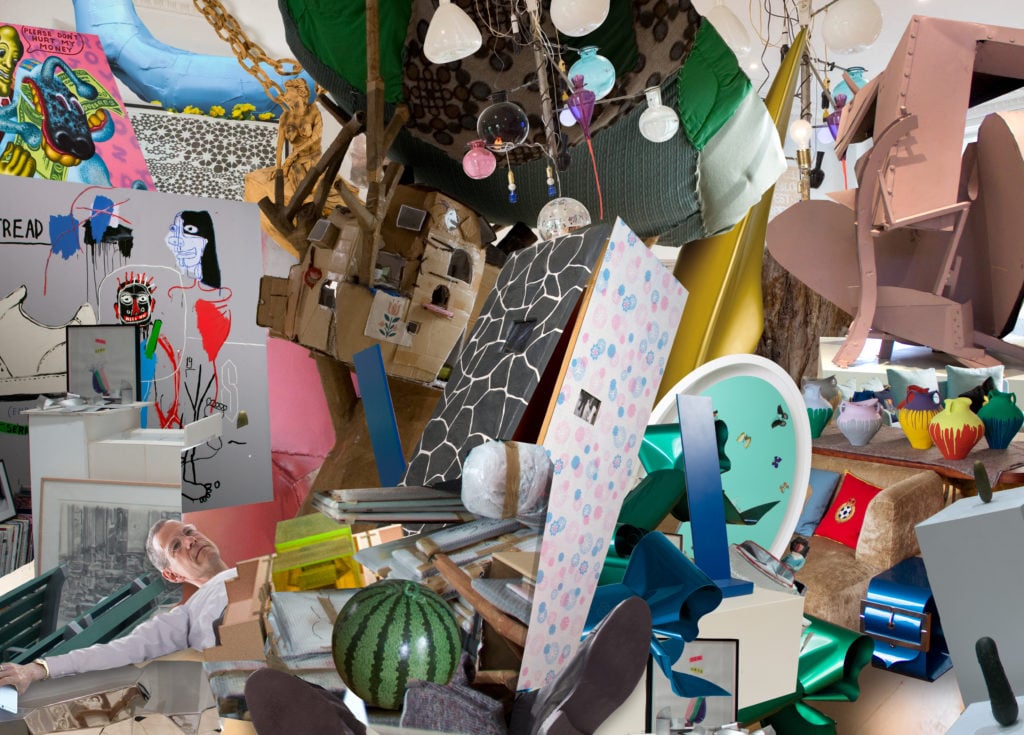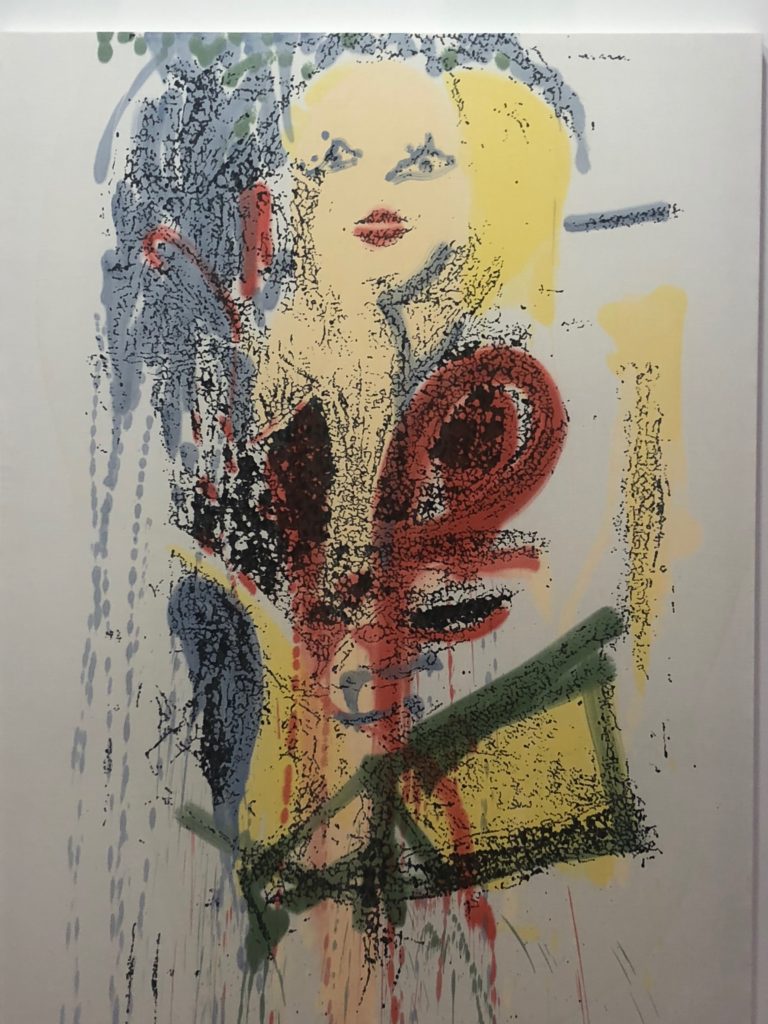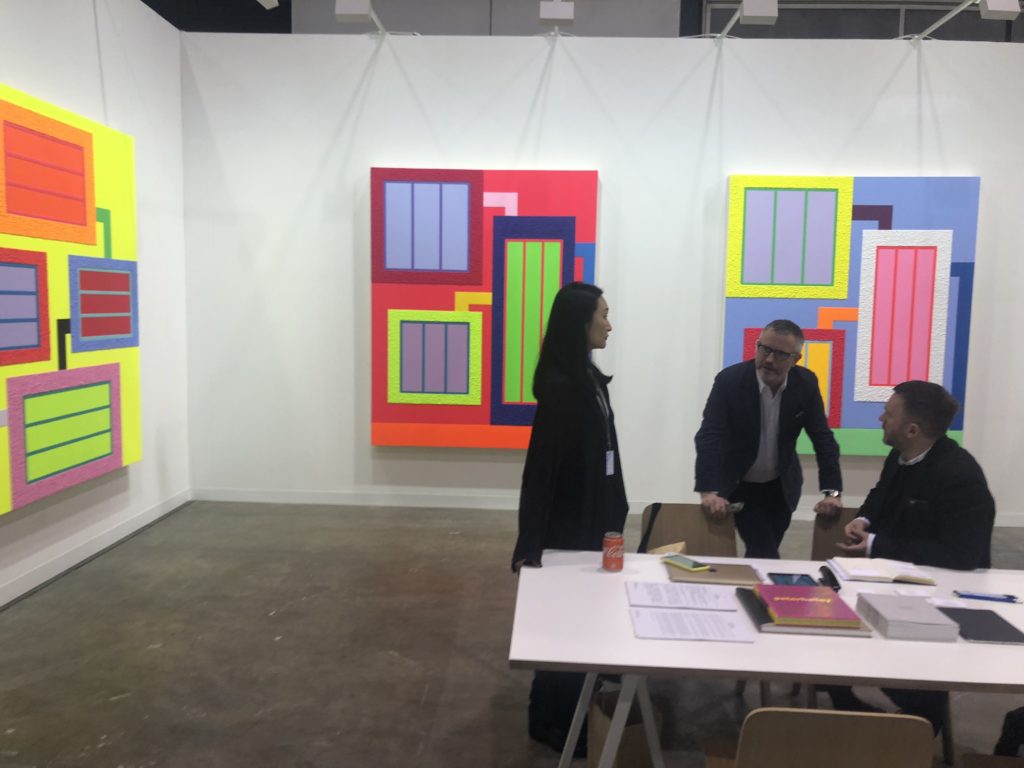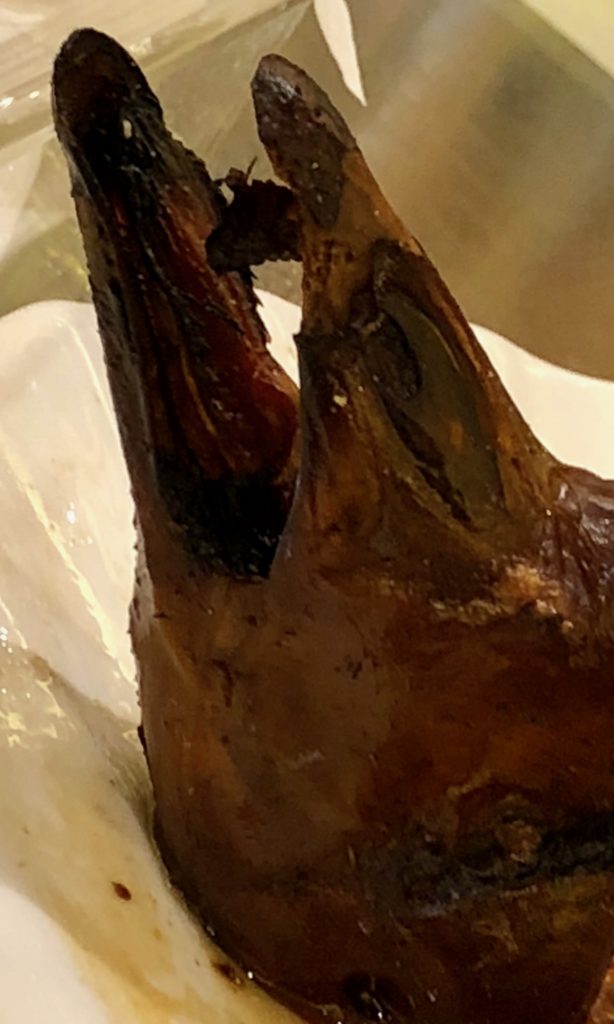Opinion
Kenny Schachter Gets Overwhelmed at Art Basel Hong Kong—and Almost Gets Punched in the Face, Too
In Hong Kong, enemies lurk at parties and art-fair booths alike, our columnist finds.

In Hong Kong, enemies lurk at parties and art-fair booths alike, our columnist finds.

Kenny Schachter

Wandering around Art Basel Hong Kong last week, I wondered what Andy would make of all this—fairs, Instagram, and the unstoppable beast the art market has become. For some perspective, his lifetime auction record was $385,000 in 1986 for 200 One Dollar Bills, which subsequently sold for 43,762,000 one-dollar bills in 2009. I did some digging and found that Warhol visited a single fair in his lifetime, Art Cologne (see you there next month). I can imagine him, entourage in tow, taking lots of supersonic selfies, maybe with a booth of his own—not too unlike the circus figure Jeff Koons morphs into in front of any of his overproduced baubles, like he did at Zwirner’s stand at the fair. His giant shiny bird planter shown there was unsold as of the time of this writing.
There are always layout tweaks from one year to another, and this time the Hong Kong fair was split in two to sprawl across the first and third floors of the convention center—with many dealers in the upper reaches complaining that the action was on the lower, more easily accessible level. A common refrain was that you could “hear crickets” upstairs. Stranded on the third floor, Gavin Brown said he was homesick, which I found kind of cute (even coming from someone I didn’t much get along with for an age). It’s true: Hong Kong is a long way from home. I felt his anguish and left a day earlier than planned as a result—then again, I leave every fair ahead of schedule.
I should publish an e-leaflet called Kenny’s Price List, as I’m notorious for printing prices, often against the will of galleries, who would prefer to keep it all hush-hush at every fair I attend (which is lots). That’s when “the monster” comes in handy: I used my son Kai as a price proxy to garner information, especially at Zwirner (where they have a gallerywide policy to shut me down). In New York, it’s the law to publicly list prices, whether displayed on the wall or at front desk—although 100 percent of galleries in the city ignore the dictate.

Kai lifts the veil on a Rirkrit Tiravanija, maybe a little too zealously, whoops! Photo by Kenny Schachter.
Christophe Van de Weghe, a hardworking fair stalwart, is like a machine. He had an amazing early Basquiat, fairly priced at $3.6 million, even if that number was less aggressive because of the doohickey the painting was stretched on (or so I’d gather). When I told him it seemed very fairly priced he replied, “My prices are always reasonable. My art is priced to sell, and that’s why I sell a lot.” More dealers should copy his act.
The VIP opening drew large crowds to the convention center, making some a bit nervous about what hordes the public days might bring. One dealer girded for battle: “We ward off the masses and start playing defense!” Sounds grim. Speaking of tactical maneuvers, my former editor at artnet News, Ben Genocchio, landed on his feet as a partner at Gmurzynska Gallery after an unceremonious departure from the Armory Show, and sold a Léger at his debut Basel booth for $4.2 million. Gallery work was much easier than websites or fairs, he said with notable relief.
At every fair there are a handful of omnipresent artists, some famous, some ascendant auction-market-wise, and others gaining traction on the institutional or gallery front. Hong Kong was no different: there were more George Condos than you could shake a gavel at, and a KAWS in every gallery building, auction house, and benefit sale—even the rooftops were vulnerable. The neo-Pop artist (born Brian Donnelly) managed to attach his branding to everything but the face masks worn by many Asian residents to protect against… Western art dealers and speculators, I presume? I should design one myself. On the younger, emerging front was sculptor Alicja Kwade (b. 1979) at 303 Gallery, Johann König, and Kamel Mennour. I can assure you, Kwade’s art—featuring large interconnected rocks and metal tubes—will be rumbling down the aisles of a fair near you sometime soon (like a force majeure). Will she be able to sustain the momentum? Probably.

Nicolas Party at Modern Art (join the waiting list). Photo by Kenny Schachter.
There should be a party for painter and sculptor Nicolas Party, whose works at the booth of Scotland’s Modern Institute Gallery sold out, at between €30,000 to €66,000 apiece; Los Angeles’s David Kordansky sold a Jen Guidi “so long ago we forgot how much for,” I was cheekily told. It was a diptych for $140,000 (you get the second for free) and another green Calvin Marcus chicken painting for $50,000. Massimo De Carlo had an (unsold) Nate Lowman “Marilyn” painting for $375,000. A painting from the same series previously sold at auction for nearly $1 million in 2014 (I remember because I had sold it to Joe Nahmad shortly before the sale for $600,000). Oh, the days of yore.

Nate Lowman’s “Marilyn” at Massimo De Carlo got a haircut, going from over $800,000 to $375,000. Photo by Kenny Schachter.
Peter Halley, a tough proposition for years, is now a hot commodity, selling out at Stuart Shave’s Modern Art for between $115,000 and $120,000. (He’s having a Condo moment.) Cecily Brown, who I first exhibited in 1996 and couldn’t give away for $1,000, were impossible to come by for $800,000, briskly selling out at Thomas Dane. Sadie Coles, meanwhile, sold out her entire booth—nothing unusual there—which featured works by Jordan Wolfson ($325,000), Sarah Lucas (£145,000) and Laura Owens ($450,000).

Peter Halley at Modern Art. His market has gotten out of prison. Photo by Kenny Schachter.
I am a fan of the Turkish painter Haluk Akakçe and his Istanbul gallery, Dirimart, and expressed interest in a work depicting a crude-looking rabbit on their booth’s outside wall—he always seems to be hanging in remote real estate at fairs, but I really like the work. The gallerist asked if I wanted to see more, which I did, so we entered the closet (an art fair’s equivalent of a back room) and the artwork they intended to show me was on the floor shoehorned beneath a large hanging painting.

Haluk Akakçe at Dirimart. Photo courtesy of Kenny Schachter.
I offered to help liberate the work, then thought better of it and offered Kai to help, which the assistant respectfully refused. When she moved a piece of furniture, a glass of milk spilled behind the stretcher of one artwork; when she tried to remedy the situation, it only worsened—the milk funneled down the stretcher bar only to land on the face of another painting. Everyone was horrified, but she had the perfect response: “Of course, if you like the work, it would go to the artist’s studio first.” I’m sorry.
Out of the corner of my eye, I spotted an awful flipper from New York entering 303 Gallery’s booth. As I shied away out of his sightline, so as to escape detection, I heard him demand, “How much is the Stingel”—even though, while there was certainly no shortage of Rudolf Stingels on hand (you can add him to the “everywhere” list), this particular painting was by Jacob Kassay. When he was roundly corrected by gallery staff he replied, “I had one of those.” Like Gavin, I was feeling wistful for home again. Zwirner had a Sigmar Polke, all too familiar from fairs past, that was unsold at $3.2 million—possibly because Oscar Murillo’s politically correct pastiche of a Polke offered such a comparative bargain, selling for near its asking price of $400,000. Murillo recently sent me a thinly veiled anonymous email threatening me after my repeated criticisms of his work in my column, but I wish him no ill will. I am just a reporter (and own an early work!).
Speaking of people that dislike me—a lot—Lorenzo Rodriguez is a fixture at art events but not a collector or art worker. Hmm, call him a recent factor of an overheated art market. Once, at dinner in New York, he lashed out at me for no ostensible reason in front of some very successful and confused friends and clients of mine, despite the fact that there had been no prior relationship between us in speech or print. Ok, so maybe I wrote about the experience after the fact, and made an artwork featuring him to illustrate the occurrence, but wouldn’t you?

The Beyeler party (post fisticuffs). Photo by Kenny Schachter.
After a day at the fair, Kai insisted on attending Sam Keller’s rave—I mean, Fondation Beyeler soirée—at a club featuring the rock-star DJ Seth Troxler, who I actually had heard of beforehand (we share the same accountant, thank you very much). I have a long history with Sam and revere him for almost everything, except for the time our kids hung out in Miami one night and didn’t return for a few days. Upon entering the door to the party, I immediately encountered Lorenzo, who I guess had taken umbrage at my previous story (and artwork) and lunged at me. In front of Sam. And, thankfully, Kai. To be frank, I’m a coward (unless behind a keyboard), and was bullied and beaten repeatedly throughout my childhood; still today, there are more than a few who would relish seeing me get my ass kicked, Oscar included.
Before Lorenzo could succeed in throwing his first flailing punch as I tried to ward him off with my forearm, Kai ran to his side and restrained his fist. The art dealer “friend” who I also arrived with stood by in hysterics, which was neither much help nor a revelation that he’d spectate as I potentially got KO’d. I’d recommend that Lorenzo Amazon himself a copy of Dale Carnegie’s timeless 1936 classic How to Win Friends and Influence People, pronto.

Wolfgang Tillmans and Seth Troxler in the act at Beyeler party. Photo by Kenny Schachter.
If things ever get too dark in the increasingly authoritarian world (cough, China), I could commit suicide by artnet, writing myself to death. All this for a stipend that wouldn’t even pay my medical bills had I been hit. The party, at least, was insane (in a good way), and Wolfgang Tillmans showed up to co-DJ. There is nothing to describe the elation on the face of a musician mid-set—it’s contagious and beautiful—and Wolfgang had the sweaty crowd eating out of his hand. His show at Zwirner’s H Queens gallery wasn’t bad either, where you’d pay about $120,000 for a full-sized photo (can’t help myself—sorry, DZ). When my kids hang out with me, it’s fun, yes, but they also assume the much-needed role of my superego. They can stop a punch, too, it seems. Maybe I won’t yell at Kai (as much) for leaving the lights on at home.

Thank you, I’m full. Photo courtesy of Kenny Schachter.
To be clear—in case I wasn’t—people were throwing down money like nobody’s business at Art Basel Hong Kong, at least when they weren’t gobbling up local treats like chicken testicles and boiled cow lung, yum. I had a bet as to who would get diarrhea first—I even ate jellyfish while still healing from a brutal sting over the summer. Oh, and I’d be remiss not to recount the night out when a young gallerista mentioned that her boss absent-mindedly lost a Bacon triptych (or was I hallucinating?). Art-fair life means living at an accelerated pace for short periods devoid of news of the outside world, exercise, or much non-art-related stimulus altogether—an all-encompassing sensory trip (and that’s when it works as it should!).
The downside: long-haul flights are a glorified cauldron of bacteria, and I’ve been sick on and off (more on) since the end of January. En route to Beijing, I witnessed a wicked sneezing fit on the plane, and I’ve been fluish every day since; on the way home, I reciprocated, spewing germs and coughing incessantly. Antibiotics are my new vitamins, and my new KAWS hospital mask will come in handy. You could classify a travel-induced, chronic-immune-suppression disorder by the name of “art fair/auction-itis.” My lungs are unfit for soup. Collyer Brothers Syndrome was another sickness named after a pair of brothers who hoarded themselves to death in 1947, an affliction I could readily identify with along with many others on the art-acquisition odyssey—even though I escaped this round without buying anything. Imagine the heaps of artworks at the homes of fair-frequenting collectors… they must be even more jam-packed that Dirimart gallery’s booth. It’s incredible no one suffocates beneath the weight of all that art (that we know of).
As for China, maybe the tightly controlled nation is after no less than world domination, and perhaps they will indeed succeed, sucking up resources and intellectual property at internet-speed but with the simultaneous patience of a grandmaster chess player. Once you get past the chicken balls, would that be such an awful thing? At least, most likely, the censors would spare you the grief of reading this column.